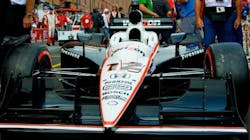Baltimore Grand Prix proves value of interagency video sharing
Anyone that has ever been involved with integrating video surveillance systems from a variety of entities knows how much of a challenge it can be to bring all of the parties involved onto the same page for the greater good. That challenge can prove even more difficult if those parties happen to be municipal, state or federal agencies that are used to working within their own silos with their own operating procedures for video surveillance assets.
The city of Baltimore, Md., which has been on the leading edge when it comes to municipal surveillance, was recently able to accomplish this feat during the Baltimore Grand Prix IndyCar Series race that took place in the city last September.
In a webinar adapted from the Secured Cities conference and hosted by SIW on Thursday, Baltimore Police Department Lt. Samuel Hood III, director of law enforcement operations for the CitiWatch program, Stefan Waters, director of technical operations for CitiWatch, and Michael O’Dea, vice president for business partnerships at VidSys, discussed how they were able to create a common operating picture for the race by tying together disparate surveillance systems using a PSIM platform.
According to Hood, the goal of the video sharing initiative was to minimize public safety concerns for the event by being able to provide real-time situational response through the utilization of these various video systems. The project eventually integrated cameras from 10 different city, state, federal, and private entities including; Baltimore’s CitiWatch program; the Maryland Transportation Authority; the Maryland Department of Transportation; the Baltimore Department of Transportation; the Maryland Stadium Authority; FBI; and, the Hilton Baltimore hotel. Altogether, the initiative tied together more than 750 cameras, which were fed into multiple command centers.
In addition to protecting the race itself, authorities also wanted to be able to keep a close eye on six fuel tankers that had to be brought in for the event, prevent traffic disruptions, as well as be able to respond to their normal daily duties and responsibilities. Hood said that two unplanned incidents that happened prior to the race – Hurricane Irene and the earthquake that was felt up and down the eastern seaboard – provided them with an opportunity to prepare for the situational response that would be needed during the event.
One of the biggest challenges of the project, aside from the obvious technical hurdles of tying together disparate systems, according to Hood, was who had ownership and control of the devices. To solve this, they allowed only the cameras’ respective owners to record footage or control them because the primary goal was to have that common operating picture for everyone involved.
"Everyone, including the governor of Maryland, saw the benefits of this program and having a common operating picture," he said.
According to O’Dea, another key to this project was the fact that is was privately funded, which not only sped up the process but also resulted in tremendous cost savings for the city and state.
"What all this is doing is saving unbelievable amounts of money," O’Dea explained.
In the future, O’Dea said that they would look into integrating other data systems into video sharing initiatives, such as Computer Aided Dispatch (CAD) so that everything is geospatially aligned for operators.
"It’s a groundbreaking project," he added.
In the past, Waters said that to be able to integrate all of these video systems would have required having different computers with different user names and different passwords to access each one.
"What happens in those scenarios in those PCs sit and no one uses them," Waters said. "Now, I don’t have five or six different systems. I’ve got one common operating picture."
Click here to listen to this webinar in its entirety, which will be available after 1 p.m. on May 4, 2012.
